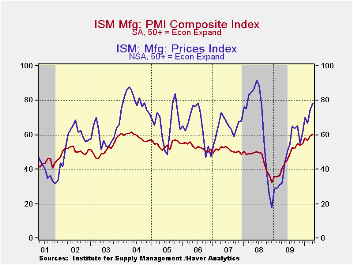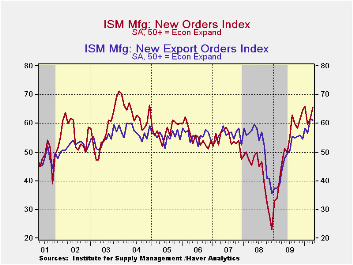 Global| May 03 2010
Global| May 03 2010Job Gains Help Lift ISM Factory Sector Index
by:Tom Moeller
|in:Economy in Brief
Summary
Employment growth is helping to underpin the recovery in factory sector activity. According to the Institute for Supply Management, the level of activity grew last month at the fastest pace since June of 2004. The April composite [...]

Employment growth is helping to underpin the recovery in factory sector activity. According to the Institute for Supply Management, the level of activity grew last month at the fastest pace since June of 2004. The April composite index rose to 60.4 and slightly beat Consensus expectation for a rise to 60.0. It was up from the low of 32.9 reached in December '08. (Any figure above the break-even point of 50 suggests rising activity.) The ISM data is available in Haver's USECON database.
The index for factory sector hiring activity posted its strongest monthly gain since last November and, at 58.5, was at its highest since June of 2004. The reading is up from the low of 25.9 last February. Twenty-six percent of firms indicated a higher level of payrolls versus 7% last April. Just 6% showed a lower level versus 35% one year ago. During the last ten years there has been a 90% correlation between the index level and the three-month change in manufacturing payrolls.
Boding well for future hiring, it actually was the production component which posted the strongest m/m increase during April with a rise to 66.9. During the last ten years there has been an 84% correlation between the level of the production component of the composite index and the three-month growth in factory sector industrial production. It is appropriate to correlate the ISM index level with factory sector output growth because the ISM index is a diffusion index. It measures growth by using all of the positive changes in activity added to one half of the zero change in activity measures.
The new orders index also rose and, at 65.7, it showed improvement similar to the hiring index. Fifty-two percent of respondents reported higher orders versus 31% last April. Just 8% reported order declines versus 29% last year. Finally, the export order index slipped just slightly to 61.0 after its March surge to 61.5 which was its highest since 1988. That was up from the low of 35.5 in December '08. During the last ten years there has been a 53% correlation between the index and the q/q change in real exports of goods in the GDP accounts.
Offsetting these increases was a lower inventory component which fell to 49.4 from 55.3 in March. Still, 20% of respondents indicated that they were raising inventory levels versus 11% last April while just 19% indicated lower inventories versus 42% one year ago. Also down and despite improvement in orders and production, the pace of supplier deliveries quickened. The supplier delivery index fell to 61.3 from its March high.
The separate index of prices paid rose to 78.0, a new high for this recovery. That was up from the December '08 low of 18.0. Sixty percent of respondents reported higher prices while only 4% indicated lower prices. During the last twenty years there has been an 83% correlation between the price index and the three-month change in the PPI for intermediate goods.


| ISM Mfg | April | March | February | April '09 | 2009 | 2008 | 2007 |
|---|---|---|---|---|---|---|---|
| Composite Index | 60.4 | 59.6 | 56.5 | 40.4 | 46.2 | 45.5 | 51.1 |
| New Orders | 65.7 | 61.5 | 59.5 | 46.5 | 51.6 | 42.1 | 54.3 |
| Employment | 58.5 | 55.1 | 56.1 | 35.0 | 40.5 | 43.3 | 50.5 |
| Production | 66.9 | 61.1 | 58.4 | 41.0 | 50.4 | 45.2 | 54.1 |
| Supplier Deliveries | 61.3 | 64.9 | 61.1 | 45.9 | 51.4 | 51.6 | 51.2 |
| Inventories | 49.4 | 55.3 | 47.3 | 33.7 | 37.1 | 45.5 | 45.4 |
| Prices Paid Index (NSA) | 78.0 | 75.0 | 67.0 | 32.0 | 48.3 | 66.5 | 64.6 |
Tom Moeller
AuthorMore in Author Profile »Prior to joining Haver Analytics in 2000, Mr. Moeller worked as the Economist at Chancellor Capital Management from 1985 to 1999. There, he developed comprehensive economic forecasts and interpreted economic data for equity and fixed income portfolio managers. Also at Chancellor, Mr. Moeller worked as an equity analyst and was responsible for researching and rating companies in the economically sensitive automobile and housing industries for investment in Chancellor’s equity portfolio. Prior to joining Chancellor, Mr. Moeller was an Economist at Citibank from 1979 to 1984. He also analyzed pricing behavior in the metals industry for the Council on Wage and Price Stability in Washington, D.C. In 1999, Mr. Moeller received the award for most accurate forecast from the Forecasters' Club of New York. From 1990 to 1992 he was President of the New York Association for Business Economists. Mr. Moeller earned an M.B.A. in Finance from Fordham University, where he graduated in 1987. He holds a Bachelor of Arts in Economics from George Washington University.






